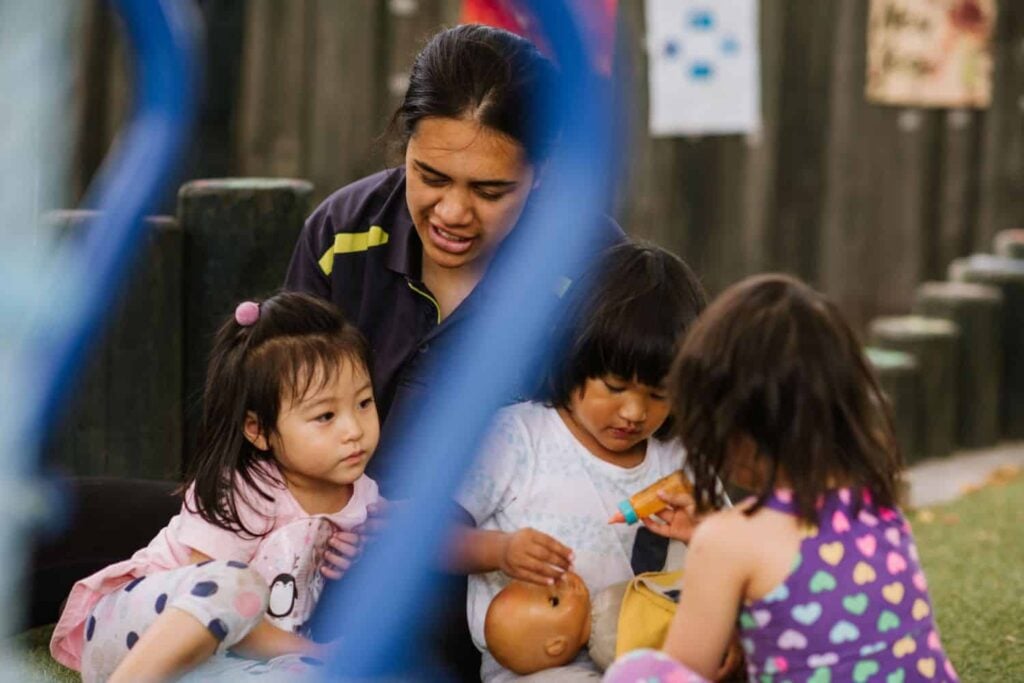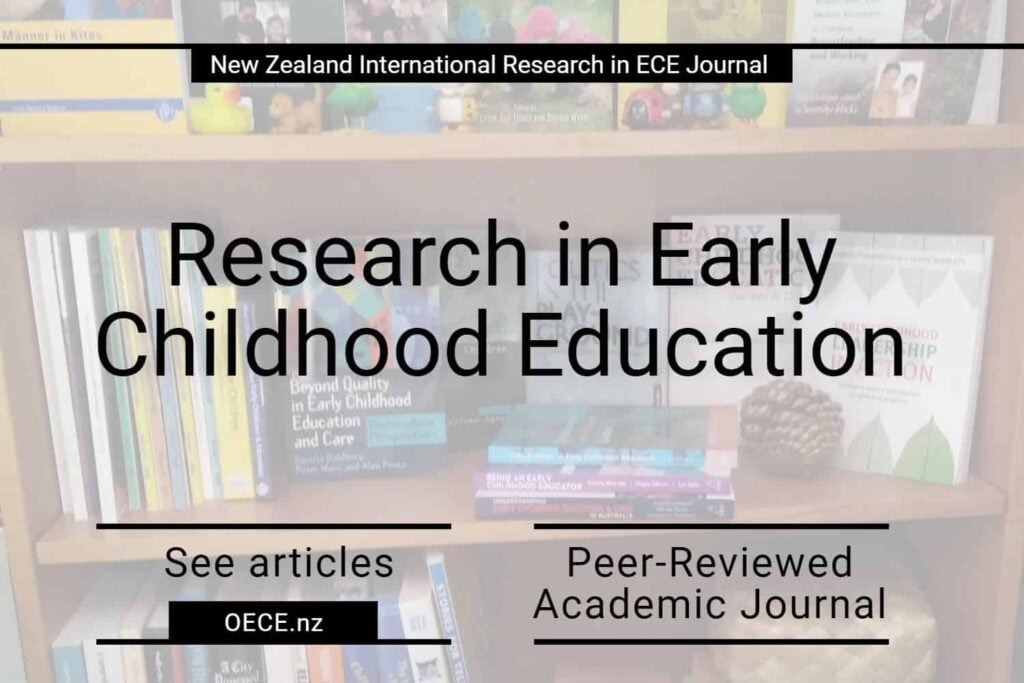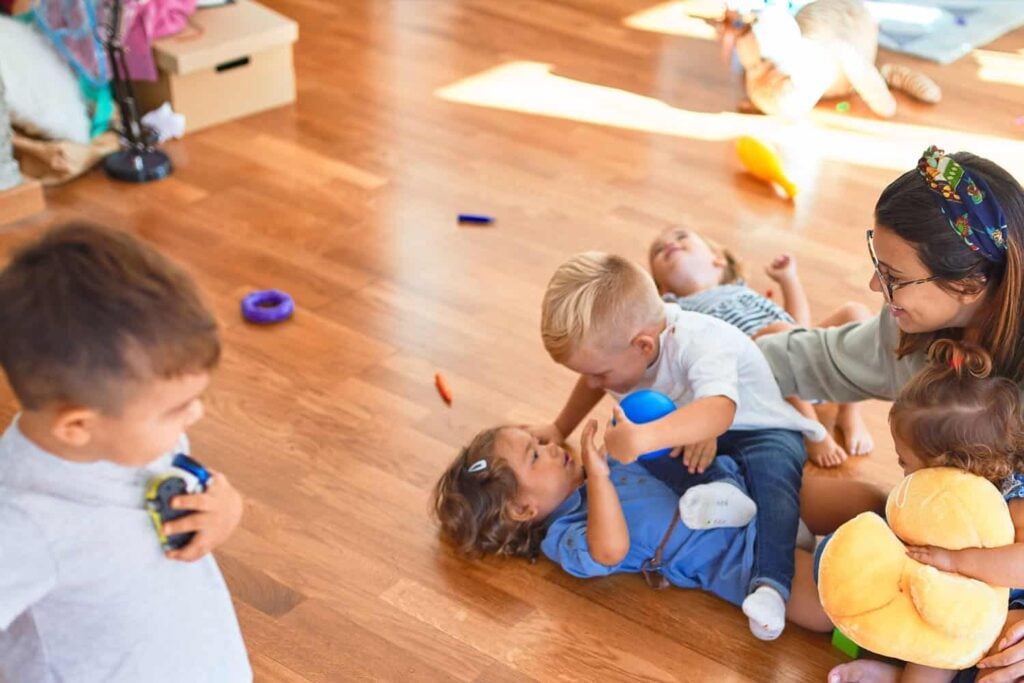Group Size in Early Childhood Centres.
Dr Sarah Alexander.
May 11, 2011.
Definitions:

Licence size means the total of the number of children a centre can legally have on its premises for the purposes of care and education, according to the licence issued to it by the Ministry of Education.
Group size means the specific number of children grouped together within a facility who interact together with the same teacher/s in their own assigned space or classroom.
Centre Licence Size Number Acts to Set A Limit On Group Size
Licence size has acted as a substitute regulation for group size in NZ because we do not regulate for group sizes within centres unlike many other countries.
How Group Size in Early Childhood Centres Affects Teaching and Learning
In one study, teachers in larger groups at kindergartens (45 children compared to 30) reported that the larger group had negative consequences for both teachers and children. Children were overwhelmed in larger groups, and had to compete more for equipment, space and teacher time. Teachers said they found it difficult to do individual or small-group work with children, and that their interactions with children were less positive. Head teachers considered that their job had moved to become one of ‘crowd control’ and they missed the quality of the teacher/child interaction they used to provide.
Even though the adult/child ratio remained constant at 1:15, the larger group size was overwhelming for young children and had had a marked impact on the type of activities teachers were able to offer (Renwick & McCauley, 1995)
A Controversial Regulation Change
The change in early childhood regulations from 1 July 2011 to allow early childhood centres and hospital-based early education programmes to have up to 150 children (0 – 6 years) or 75 infants/toddlers (under 2 yrs) is controversial. Why?
Here are some reasons:
- 150 children of any age (up from 50 children) or 75 infants (up from 25) becomes the new maximum group size in early childhood centres.
- Within the early childhood profession such a number of children is considered way too many.
- Any increase in number flies in the face of clear understandings within the large body of research on quality in early childhood education that small group size is important for: (a) supporting responsive and stimulating interactions, (b) children’s health, (c) children’s learning outcomes, (d) and infants developing secure attachments.
- Earlier parent and sector consultation by the Ministry of Education as part of revising the early childhood regulations in 2004 and 2008 did not indicate widespread support for an increase in licence size. Moreover, the announcement of the regulation amendment change in early 2011 was a surprise to all in the early childhood sector with the exception of one political lobby group acting on behalf of mostly commercial childcare financial interests.
- The political reason for increasing the licence size maximum and not introducing regulation for class size/group size to counter potential negative effects for children and adults was to reduce compliance and staffing costs for ECE operators with multiple services on the same site (thereby reducing the potential for criticism of its freeze on funding rates) and to encourage operators to expand capacity and create more places for children to support government goals for increasing participation.
In the video below the former Minister of Education outlines the rationale behind the decision to change the regulation for licence size, and therefore also increase group size in early childhood centres.
(Click on the arrow play button to listen)
The Minister explains the change in regulation for centre licence size as being good for centre owners that currently hold multiple licences on the same physical site. It will help them to reduce costs and paper-work by moving to a single licence. What she does not note is that (a) there are no rules limiting the size of groups within the new licence number, and (b) services with more than 150 children on the same site will still need to apply for an extra licence/s.
Fifty to 150 children and from 25 to 75 under-two-year olds is a huge leap in child numbers, not to mention the many more adults a child will have to get to know as part of being of part of a much larger group. For as long as there has been childcare/daycare regulations the maximum licence size has been set at 50 children (0 – 6 yrs) and up to 25 infants and toddlers in New Zealand. Even so, 50 children has been considered to be too many to be cared for in a group. For example, Kindergartens which primarily cater for pre-schoolers have historically limited their numbers to 30 and up to 45 children.
Staff child ratio and group size indicators—two of the best indicators for determining the quality of a child care program. These two indicators significantly effect many other health and safety issues, such as the transmission of disease being greater when there are more children and adults present. These two indicators improve the caregiving behaviors of staff and the safety of children. And on the mental health and school readiness side, more secure attachments occur with higher staff child ratios and smaller group sizes.
(Fiene, 2002)
Previous Ministry of Education Consultation Indicated Larger Numbers Not Wanted
At the time of the ECE Regulatory Review 2004, the Ministry of Education suggested “a shift from licence size and group size being treated as one and the same thing, to separate regulation to provide for small group sizes in centres whatever their licence size”.
The Ministry cited the NZ early childhood curriculum document Te Whariki as an example of one justification for the need to introduce separate regulation to set limits on group sizes within the licence size.
Infants should not be exposed to too many new faces or situations. (Te Whariki)
Feedback was asked on the following proposal to introduce new regulation for group size:
- 12 would be the maximum number of children under 1 year of age
- 20 would be the maximum number of children aged between 1 and 2 years
- 30 would be the maximum number of children aged 3 years and older
Of the submissions received by the Ministry from the sector and other interested parties, the spilt between those who agreed (34%) and those who disagreed (38%) was quite close. This was a difficult question, or perhaps even a poorly worded question, to ask. The question combined two issues: group size and the introduction of a new age band for 1 to 2 year olds (there are only 2 age bands in NZ early childhood education regulation one for under 2s and one for over 2s).
At the time of the 2008 ECE Regulations Review in answer to a question of whether government should regulate for maximum centre licence size, the Ministry received 275 responses in support of regulating maximum centre size and 78 responses against. Thus the majority wanted regulatory limits on the number of children. In relation to feedback received from parents consultation meetings support for the idea of bigger being better was not found.
What parents wanted was for early childhood services to be places where everyone knew their child’s name.
“Overall parents felt there should be regulations for maximum centre size and that the maximum centre size should ideally be between 30 and 50 children at any one time. Despite adult-child ratios, parents felt that in smaller centres all staff would be familiar with their child and more able to offer one-on-one attention. Parents expressed concern about the potential of ‘battery processing’ in larger centres” (ECE 2008 regulations review summary report).
Parents said that multi-site licences should not be provided and that while some of the licensing requirements are transferable (e.g. enrolment policies) and could be used for multi-site providers during the licensing process, each physical site should be licensed individually to ensure that it meets requirements.
Survey Results on Centre Licence Size
The results of independent online survey of 450 people about the centre/licence size increase showed substantial opposition against the regulation change. One important finding in particular to note is that the majority of people involved in services with more than one licence whose service would likely financially and/or administratively benefit, were also opposed to the regulation change mainly for reasons that it did not appear to be in the best interests of children (and of staff).
The Minister of Education’s office initially at least, did not show awareness that while this change might help to reduce some bureaucracy and trim costs for larger services, it also had a downside. The downside included possible negative implications for children’s health and learning outcomes and also possibly for the financial sustainability of smaller and locally owned services.
The Minister was given a summary of the main survey findings and outline of the issues. And we received a reply which the Minister is happy for us to share with you – see the Minister’s response
The Minister acknowledges a desire to alleviate the potential problems or negative implications of the regulation change and has “directed ministry officials to provide strengthened guidance to the sector to support high quality in larger sizes, including information on group size”.
There is plenty of guidance available in the international literature on the vital necessity of limiting group sizes within the larger centre population and on the optimal sizes, physical space for, and staffing arrangements for groups.
See the article by journalist Rachel Grunwell in the NZ Herald newspaper, click here …
Regulations for Group-Size
Standards for group size, staff training/qualifications and adult-child ratios, are the three key pillars of early childhood regulations in many countries. NZ regulates currently for staff qualifications and adult-child ratios but not for smaller group sizes within the main centre population.
Here are two examples of group size requirements in Australia.
New South Wales – regulations for group size in early childhood centres
- if the children are under 2 years of age, in groups of not more than 12,
- if the children are 2 or more years of age but under 3 years of age, in groups of not more than 16,
- if the children are 3 or more years of age but under 6 years of age and do not ordinarily attend school, in groups of not more than 20.
Australian Capital Territory (ACT) Children’s Services Standard – the maximum allowable size of groups in early childhood centres:
- 15 children for children aged birth to two years;
- 20 children for children aged between two to three
- years;
- 33 children for children aged three to five years; and
- For mixed age groups or family grouping, the maximum group size for the youngest child must be adhered to unless otherwise approved in writing by the licensing authority.
New Zealand early childhood regulation:
- 150 children aged birth to six years; and
- 75 children aged birth to two years.
The Office of the Children’s Commissioner in an inquiry into the non-parental education and care of infants and toddlers has recommended that the Minister of Education direct her officials to provide advice on:
Making a regulation that limits group size to no more than 8 under two-year-olds for purposes of supporting responsive and stimulating interactions. (p. 13 summary report “Through their Lens”, 2011)
Comments from members about Licence and Group Size in Early Childhood Centres
I think that there definitely needs to be regulation around a group size. To give the “information” to a centre is all well and good… but, unless every teacher in a centre is very uninformed in ece matters, they will already know that smaller groups are better! For example, I know that under-2’s should be in a group size of less than 10, yet I supervised a centre that had 13 under-2’s. Why? Because management (who also knew about small group sizes and who were committed to quality ece) claimed we HAD to have that many in order to break even. Giving more information about quality ece wouldn’t have influenced their decision on that group size… but having regulations around it would have influenced it!
There must be regulation around group size. From an acoustic point of view alone, the more children in a learning space the higher potential for excessive noise and harmful levels of nose to develop. Apart from the potential damage to the aural health of children (and of course staff) excessive noise which degrades speech and oral communication presents serious educational concerns for children at a time when speech and oral communication development is critical and risks are highest from middle ear infections. Furthermore it will be to the serious detriment of autistic children who are mainstreamed in early childhood centres if forced into large noisy learning spaces. They struggle enough as it is and to place them in large noisy overstimulating environments is debilitating, cruel and a degradation of their rights to an education. We as parents may have no choice but to keep them at home.
Isn’t it a shame that the government will be putting OUR future generation of children through an institution at such a precious and young age. I am lucky to work in the public sector where our centre wouldn’t consider having more than 10 under twos. On the other hand the poor children who are unfortunate enough to have to attend a centre that does, will be exposed to these ridiculous group sizes. It is evident through research that optimal learning happens for children in an environment where they have quality relationships with their peers and teachers, and they are planned for in partnership with families… HOW can teachers HONESTLY know all of the children, where they are at, and where they need to go to next? And, how can they begin to know the families personalities, cultures, values and beliefs???
Absolutely disgraceful that so called ‘educated’ people can make this decision. Seems like the education of our next generation is as simple as running a farm!!
These are our babies that deserve better than this.
Surely staff ratios are more important than group sizes.
I agree with Gavin – staff ratios are more important. Otherwise it would be logical to assume that the smallest Universities create better educational outcomes than the largest. How can that be so?
How can you possibly compare early childhood centre sizes with University classes???
The Children’s Commissioner has recommended that group size for infants not exceed 8!! I would like to see this around 9 so that the ratios of teachers to infants could be 1:3.
That number is impossible for teachers to cope with especially babies under two, we’re talking about 3 month olds. I don’t think the government in this country is promoting quality ECE.
I think child numbers need to be capped and the numbers suggested for both under 2s and overs are laughable. I think Big business is playing a part in this push, making profits out of families and children yet again. Staff ratios need to be in line with research. Serious consideration for the damage to hearing for both children and staff in such large noisy environments has not even been mentioned. In my experience smaller is better for children. I have been lucky to experience both a small and large group settings, and I surmise children in larger groups tend to have more behavioral problems due to noise, space, lack of teacher contact, and teacher stress.








